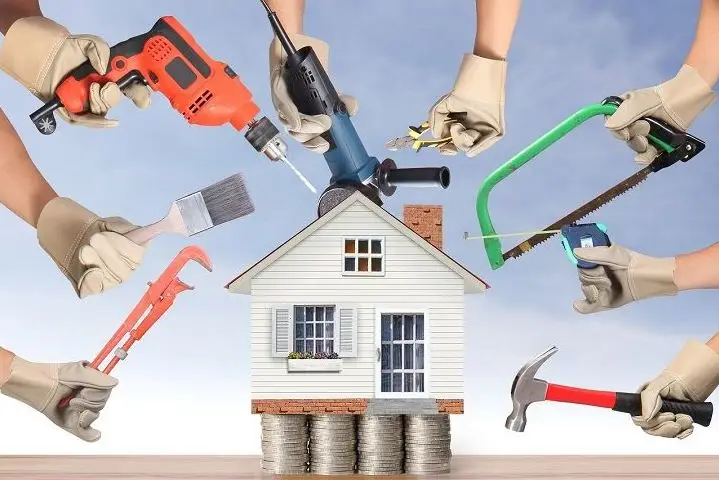Foundations & Planning Your Home Improvement
Introduction: The Journey from Vision to Reality
Your home tells your story—every wall, floor, and fixture reflects your life’s chapters. Embarking on a home improvement project is more than just an upgrade; it’s an emotional journey of transforming your space to better suit your evolving needs and aspirations. In 2025, homeowners crave smart, sustainable, and personalized solutions that elevate comfort and functionality without compromising style. This guide will walk you step-by-step from the initial blueprint to the moment you unlock your beautifully renovated door.
1. Defining Your Goals and Scope
Before swinging a hammer, clarity is key. Ask yourself:
-
What’s driving this project? (e.g., growing family, aging-in-place, energy savings)
-
Which areas need attention? (kitchen, bathroom, basement, whole-house)
-
What’s your desired outcome? (e.g., modernize, expand, improve efficiency)
Expert Insight
“Successful renovations start with laser-focused goals. If you don’t define success, you’ll never know when you’ve achieved it.”
— Eleanor Hughes, Certified Remodeler & Project Strategist

AdobeStock build your dreamy house!
2. Setting a Realistic Budget
Money matters—and 64% of homeowners exceed their budgets due to unforeseen costs . A well-structured budget prevents mid-project panic.
| Expense Category | Typical % of Total Budget | Notes |
|---|---|---|
| Design & Permits | 5–10% | Professional fees, engineering, permits |
| Structural & Framing | 15–20% | Walls, beams, load-bearing modifications |
| Plumbing & Electrical | 10–15% | Code upgrades, new fixtures |
| Finishes (Floors, Paint) | 10–15% | Flooring, paint, trim |
| Cabinetry & Millwork | 10–15% | Built-ins, closets, custom woodwork |
| Appliances & Fixtures | 10–12% | Kitchen appliances, bathroom fixtures |
| Labor | 20–30% | Contractor, subcontractors |
| Contingency | 10–15% | Always plan for surprises |
3. Assembling Your Dream Team
Your renovation team can make or break the project:
-
Architect/Designer: Shapes your vision into buildable plans.
-
General Contractor: Manages trades, schedules, and quality.
-
Specialty Subcontractors: Electricians, plumbers, HVAC, masons—licensed and insured.
-
Inspectors & Permitting Officials: Ensure safety and code compliance.
Pro Tip: Always check references and recent project photos. Dissatisfaction often stems from poor communication, not craftsmanship.

sexy girl with her hot home!
4. Creating a Detailed Project Timeline
A phased timeline keeps everyone accountable:
| Phase | Duration | Milestones |
|---|---|---|
| Design & Permitting | 4–8 weeks | Final plans approved, permits in hand |
| Demolition | 1–2 weeks | Safe disposal of debris, site prepped |
| Rough-in (Plumbing, Elec.) | 2–4 weeks | Pipes, wires, HVAC ducts installed |
| Structural Work | 2–3 weeks | Framing, beams, any foundation modifications |
| Inspections | 1 week | Rough-in and framing sign-offs |
| Finishes & Millwork | 3–6 weeks | Drywall, flooring, trim, cabinetry |
| Final Install & Punchlist | 1–2 weeks | Fixtures, appliances, final touches, walk-through |
5. Prioritizing Sustainability & Smart Tech
2025 homeowners demand eco-friendly and connected homes. Consider:
-
Energy-Efficient Windows & Insulation: Reduce bills by up to 25% .
-
Smart Thermostats & Lighting: Automate comfort and save energy.
-
Low-VOC Paints & Recycled Materials: Healthier air and reduced environmental impact.

sexy-woman-posing-building-site-portrait-desirable-home-improvement-works
With clear goals, a solid budget, the right team, and a timeline in place, you’re ready to break ground. In Part 2, we’ll delve into the nitty-gritty of demolition, structural updates, and the seamless integration of mechanical systems—complete with a second data table, a real-life case study, and expert troubleshooting tips.
Construction & Execution: Turning Plans into Progress
Introduction: Moving from Paper to Reality
Now that you’ve laid the groundwork with your design and planning, it’s time to bring the vision to life. This phase requires careful attention to detail, the precision of skilled workers, and a constant check on timelines and budgets. Whether you’re knocking down walls or adding custom cabinetry, each decision impacts the final outcome. Here, we’ll guide you through the core elements of the construction phase and provide you with actionable insights and pro tips to keep the project moving forward smoothly.

seductive-young-woman-poses-hardhat-revealing-outfit-beautiful-young-woman-hard-hat-revealing-outfit-poses
1. Demolition: Clearing the Path for Progress
Before construction can begin, demolition is essential. But don’t think of it as just “tearing things down”—it’s about setting a clean slate while salvaging reusable materials. Here’s a checklist for a smooth demolition process:
Demolition Checklist:
-
Survey the Site: Identify areas for removal. Keep what’s needed for future use (e.g., materials, plumbing).
-
Disposal Plan: Rent dumpsters or arrange for recycling.
-
Safety First: Make sure the site is secure and workers are protected.
-
Utilities Off: Confirm water, electricity, and gas lines are safely disconnected.
Pro Tip: Salvage materials like hardwood floors, cabinetry, or doors for repurposing—good for the environment and your budget!
2. Structural Changes: Building the New Foundation
With a cleared space, now comes the heavy lifting. Whether you’re adding a room, knocking down walls, or altering the layout, structural changes are crucial to the integrity and safety of your home. Let’s take a look at how to approach this:
-
Load-Bearing Walls: Always consult a structural engineer when removing or altering load-bearing walls.
-
Foundation Work: Any changes to the layout or square footage need solid foundation work. Reinforce the existing foundation or install new footings if required.
-
Framing & Framework: The skeleton of your renovation must be square and level—double-check measurements at each stage to avoid costly fixes later.
| Structural Changes | Tasks | Timeframe |
|---|---|---|
| Foundation Reinforcement | Excavation, concrete pouring | 2–3 weeks |
| Wall Removal or Addition | Framing, beams, header installation | 2–4 weeks |
| Floor Plan Alteration | Layout planning, floor leveling, subfloor work | 1–2 weeks |

brunette-woman-builder-uniform-makes-renovations-woman-brunette-woman-builder-uniform-makes-renovations
3. Plumbing & Electrical Work: The Hidden Backbone
The heart of your home’s functionality lies in its plumbing and electrical systems. Whether you’re adding a bathroom or installing new appliances, these systems need to be designed and installed properly. Pay special attention to:
-
Plumbing Layout: Rework supply lines and drainage systems to accommodate new fixtures.
-
Electrical Wiring: Ensure the electrical system can handle the added load, especially for high-demand areas like kitchens and bathrooms.
-
HVAC Integration: Alterations to the layout may require a reconfiguration of ducts or venting systems.
Expert Insight: “One of the most overlooked aspects of home renovations is upgrading electrical panels. If you’re adding significant appliances or rooms, don’t underestimate the need for a bigger electrical panel.”
— Markus Lee, Master Electrician

sexy-woman-checks-repair-plan-laptop-taking-notes-paper-young-sexy-woman-checks-repair-plan-laptop-taking-
4. Inspections: The Essential Quality Check
Once structural and mechanical systems are in place, inspections are a must. Ensuring all work meets code is vital to your safety and the longevity of your improvements. Common inspections include:
-
Framing & Foundation: Before covering up walls, make sure everything is plumb, level, and square.
-
Electrical & Plumbing Rough-ins: Ensure wiring and pipes are up to code before closing up walls.
-
HVAC: Check ductwork for leaks and adequate airflow.
Pro Tip: Don’t skip the inspection phase—passing inspection now can prevent costly fixes later.
5. Finishing Touches: The Art of Detailing
Now that the structural and mechanical work is complete, it’s time to add the finishing touches that transform your renovation into a space that feels cohesive and polished. Key aspects include:
-
Drywall & Paint: These create the backdrop for your room and can dramatically affect the atmosphere.
-
Flooring: Hardwood, tile, or carpet—choose based on your functional needs and aesthetic preferences.
-
Trim & Molding: Adds depth and elegance, especially in high-end remodels.
-
Cabinetry & Custom Woodwork: Fine-tuned to your taste and functionality.
| Finish Type | Expected Costs | Duration |
|---|---|---|
| Paint | $500–$2,500 (depending on space) | 1–2 weeks |
| Cabinet Installation | $3,000–$10,000 | 2–4 weeks |
| Flooring | $1–$5 per sq. ft. | 1–2 weeks |

sexy-woman-uniform-checks-house-repair-plan-laptop-young-sexy-woman-uniform-checks-house-repair-plan
The construction phase is where your plans truly take shape. From demolition to framing, plumbing to finishing, each step is a building block in your dream home. In Part 3, we’ll look at the final steps—inspection, final touches, and completing your punch list. We’ll also tackle common mistakes to avoid, DIY tips for small projects, and share a few expert insights to ensure you’re fully satisfied with your newly transformed space.
Finalizing Your Renovation — Inspections, Touches & Beyond
1. Final Inspections & Approvals
Before you move back in, ensure every system is safe and compliant:
-
Building Department Sign-Off: Verify electrical, plumbing, and structural inspections have passed.
-
Energy & Efficiency Audit: Confirm insulation, windows, and HVAC meet performance targets.
-
Occupancy Permit: In some jurisdictions, a final permit is required before using new living spaces.
Pro Tip: Keep all inspection documents in a digital folder—future buyers and your insurer will thank you.

2. Punch-List Completion
A thorough punch-list guarantees you’re not left with loose ends:
| Item | Details | Status |
|---|---|---|
| Touch-up Painting | Nicks, scuffs, door frames | ☐ |
| Trim & Caulk | Baseboards, window sills | ☐ |
| Hardware Adjustment | Doors, drawers, cabinet handles | ☐ |
| Fixture Tightening | Light switches, faucets, railings | ☐ |
| Clean & Debris Removal | All surfaces, HVAC filters | ☐ |
3. Common Mistakes to Avoid
-
Rushing the Punch List
Skipping minor repairs leads to long-term dissatisfaction. -
Neglecting Warranty Registration
Register appliances and systems immediately to secure coverage. -
Overlooking Seasonal Prep
Winterize new plumbing; seal gaps before the heat. -
Underestimating Storage Needs
Without built-in storage, clutter re-appears quickly.
4. DIY Touch-Ups & Small Projects
Even post-renovation, simple DIY can personalize your space:
-
Install Floating Shelves: Under $100 and one afternoon’s work.
-
Swap Out Outlet Covers: Modern metal or wood-grain plates elevate finish.
-
Add Accent Wall: Peel-and-stick wallpaper or a bold paint color.
Expert Insight: “Small DIY updates give your home more personality than any mass-produced décor.— Jana Patel, DIY Home Blogger”

portrait-desirable-sexy-woman-posing-building-site-home-improvement-works-sexy-woman-posing-building-site
5. Case Study: The Miller Kitchen & Bath Transformation
Project Scope: 200 sq. ft. kitchen + 80 sq. ft. bathroom
Budget: $65,000
Timeline: 18 weeks
Highlights:
-
Open-Concept Kitchen: Removed non-load-bearing wall, installed waterfall island.
-
Energy Upgrade: LED under-cabinet lighting + smart thermostat.
-
Custom Cabinetry: Soft-close drawers with integrated spice racks.
Results:
-
30% increase in natural light
-
20% reduction in monthly energy costs
-
4-inch average depth increase in kitchen storage
6. Frequently Asked Questions (FAQs)
Q1: How do I ensure my renovation adds resale value?
A: Focus on kitchens and baths—these yield the highest ROI. Use neutral palettes and quality finishes.
Q2: When should I live off-site during renovation?
A: For full-home projects or those involving major plumbing/electrical work, plan to stay elsewhere for at least the demolition and rough-in phases.
Q3: Can I handle punch-list items myself?
A: Yes—most touch-ups like painting, caulking, and hardware adjustments are DIY-friendly if you have basic tools.
Q4: What’s the ideal contingency fund?
A: Always allocate 10–15% of your total budget for unexpected costs.
Q5: How often should I perform maintenance on new systems?
A: Schedule HVAC tune-ups biannually, and check seals/caulking around windows yearly.
7. Ultimate Checklist: From Blueprint to Reality
-
Finalize design & secure permits
-
Confirm budget & build timeline
-
Hire and vet your renovation team
-
Complete demolition and structural work
-
Rough-in plumbing, electrical & HVAC
-
Pass all required inspections
-
Install finishes: paint, flooring, cabinetry
-
Set up appliances & fixtures
-
Conduct final inspection & punch list
-
Register warranties & schedule maintenance
-
Move in and enjoy your transformed home!
8. YouTube Resource
🎥 Watch:
Conclusion
A successful home improvement is more than a renovation—it’s a journey that transforms your lifestyle, boosts comfort, and increases property value. By following this structured, professional guide, you can confidently take your project from blueprint to reality, ensuring every detail reflects your vision and meets the highest standards.
Here’s to your dream home—mastered.


